

Vol. 40 (Number 34) Year 2019. Page 26
PASHKOVA, Ekaterina E. 1; KABULOVA, Evgenia G. 2 & NEVZOROV, Andrey A. 3
Received: 17/07/2019 • Approved: 18/09/2019 • Published 07/10/2019
ABSTRACT: The article describes a new management decision-making method for resolving international conflicts based on a multi-agent approach. The purpose of the paper is to summarize scientific achievements and develop methods for intelligent decision support in the management of international conflicts based on multi-agent technologies. The main research methods include systemic analysis and mathematical modeling, multi-agent approach, using scientific findings obtained in political science and conflict management. Intelligent models are based on different approaches: neural networks, genetic algorithms, fuzzy sets. |
RESUMEN: El artículo describe un nuevo método de toma de decisiones de gestión para resolver conflictos internacionales basados en un enfoque de múltiples agentes. El propósito del documento es resumir los logros científicos y desarrollar métodos para el apoyo a la toma de decisiones inteligentes en la gestión de conflictos internacionales basados en tecnologías multiagente. Los principales métodos de investigación incluyen análisis sistémico y modelos matemáticos, enfoque multiagente, utilizando hallazgos científicos obtenidos en ciencias políticas y manejo de conflictos. Los modelos inteligentes se basan en diferentes enfoques: redes neuronales, algoritmos genéticos, conjuntos difusos. |
The purpose of the research is to form a new concept and model for the operational management of international conflicts by means of multi-agent systems that would enable to reduce the labor intensity of management processes and the duration of management cycles as a result of the use of intelligent decision-support tools and organizational procedures.
The developed multi-agent system for managing an international conflict is distinguished by the specifics of rapidly developing international conflicts and the presentation of each control element in the form of dynamic profiles. The subjects of the mechanism have inertial properties, and therefore, it is necessary to build the profile of dynamic actions of functional components, as self-managed agents, with certain assumptions, and also to identify dynamic models of each subject of functional components separately.
The elements of the Operational Management (OM) mechanism in a multi-agent system are agents who make and execute decisions, as well as report on the work performed to the center.
The application of a multi-agent approach in modeling management processes for complex dynamic objects under uncertainty contributes to increased management efficiency, by virtue of providing the ability to analyze changes in the properties of the object being studied when selecting control actions, which is caused by the reduction in time required for managerial decision making (Muda et al., 2019). Thereby, the quantitative indicators of the activities of the international conflict management system are improved: the labor intensity of management processes and the duration of management cycles are reduced as a result of the use of intelligent decision-support tools and organizational procedures (Feng et al., 2016).
The advantage of the multi-agent approach lies in high performance and efficiency due to asynchronous and parallel execution of processes, in fault tolerance and reliability, since the entire system continues to operate if one of its components fails, in scalability and flexibility, owing to the possibility of adding new agents to the system. Our method for process modeling to manage complex dynamic objects in the conditions of uncertainty promotes an increase in management efficiency, by virtue of providing the ability to analyze changes in the properties of the object under study when choosing control actions by reducing the time required for decision making. As an example, we will illustrate the proposed method by solving the managerial problem of determining the type of international conflict, the number of functional units involved in conflict management, the speed of conflict management activities, and the allocation of necessary resources.
The development of an organizational and functional system of operational management in the conditions of international conflicts based on a multi-agent approach is the conceptual framework of the study. The multi-agent information technologies are dealt with by Menga et al. (2019), Rizvanov and Yusupova (2015), Nagoev (2012), Shvetsov and Dianov (2015), Avdeenko and Vasilyev (2010), Aksenov et al. (2011), Alibekov and Mamaev (2017), Antonova and Aksenov (2012), Bogdanova et al. (2014), Shunkevich (2013). The use of multi-agent systems in decision making in various areas was considered by Nagoev et al. (2017), Avdeenko and Vasilyev (2010), Samorodov (2012), Zraenko et al. (2009), Skobelev (2013), Vittikh et al. (2002). The application of neural networks for the collective solution of intellectual problems is described by Bova and Dukkardt (2012). Current problems of practical use of multi-agent systems are reflected by Kulba and co-authors (2013), Inozemtsev and Dmitriev (2012), Rizvanov (2016), Yatsenko (2014).
The prospects for the application of intelligent technologies to solve security problems are discussed by Garbuk (2016). It is proved by Nagoev et al. (2017) that the multi-agent neurocognitive architecture is an effective formalism for describing the semantics of the spatial localization of events. A generalized algorithm based on a multi-agent approach was proposed by Rizvanov and Yusupova (2015) for solving the problem of resource management, taking into account the semantic constraints of the domain.
Multi-agent management systems are created using the methods of game theory, cooperative problem solving based on distributed artificial intelligence, collective behavior of machines, scheduling theory, optimal planning and adaptive control. The above methods are presented by Menga et al. (2019), Zheng et al. (2019), Gelaim et al., (2019), Bychkov et al. (2014), Kovalenko et al. (2019), Nagoev (2012). Note that the use of multi-agent systems can reduce the labor intensity of management processes, the duration of management cycles, organizational procedures, and the time for making managerial decisions.
Systemic analysis, mathematical modeling, and multi-agent approach, using scientific findings obtained in political science and conflict management are the primary research methods. Let us schematically represent the agent system for international conflict (IC) management and resolution in Figure 1.
At the first stage, we define the set Х = {Xi} of parameters determining the state of the critical agent, where:
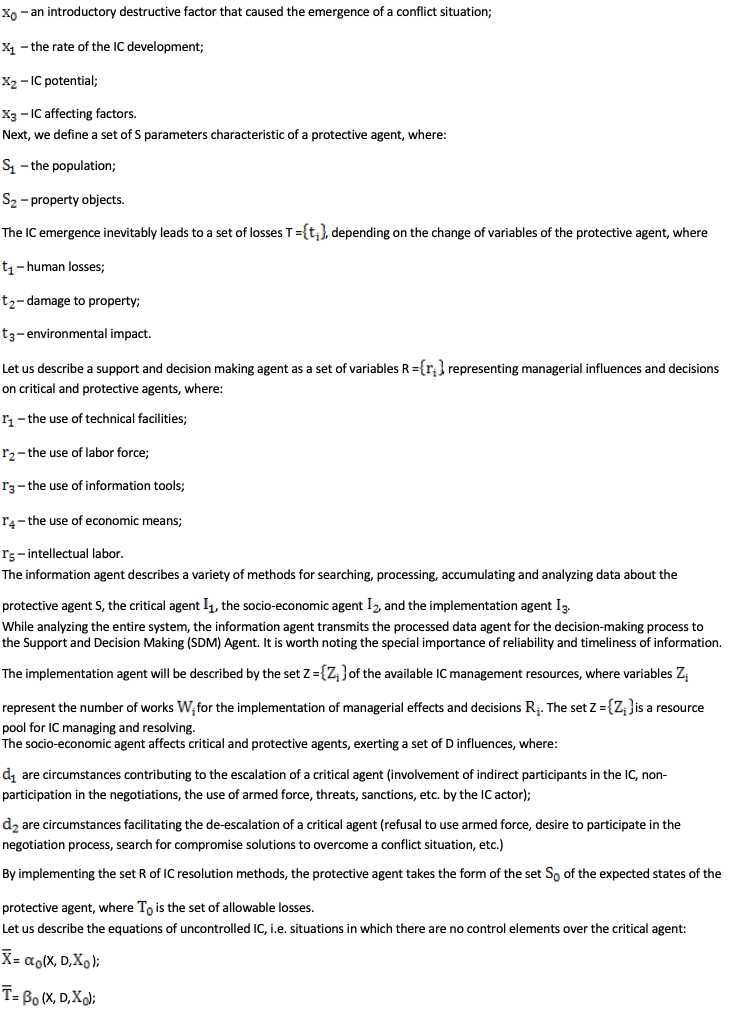
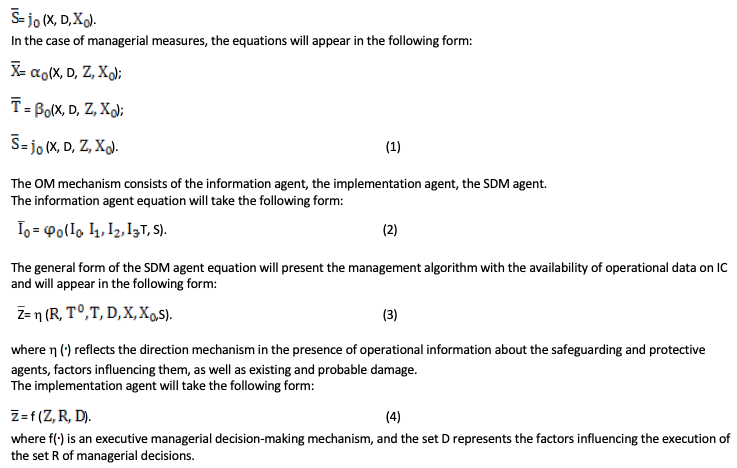
Figure 1
Agent system for IC management and resolution
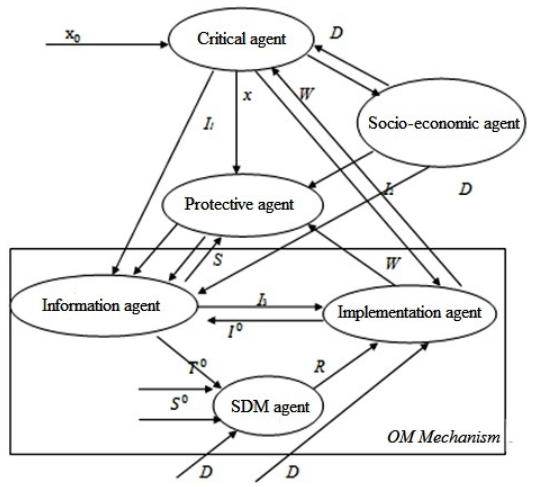
Figure 2 shows a combination of a multi-agent approach and an integrated management organization principle in the IC as a profile of ternary graphs, where each graph is a basic part of the whole mechanism.
Figure 2
Profile of integrated
management and regulation of IC
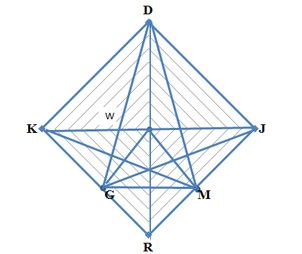
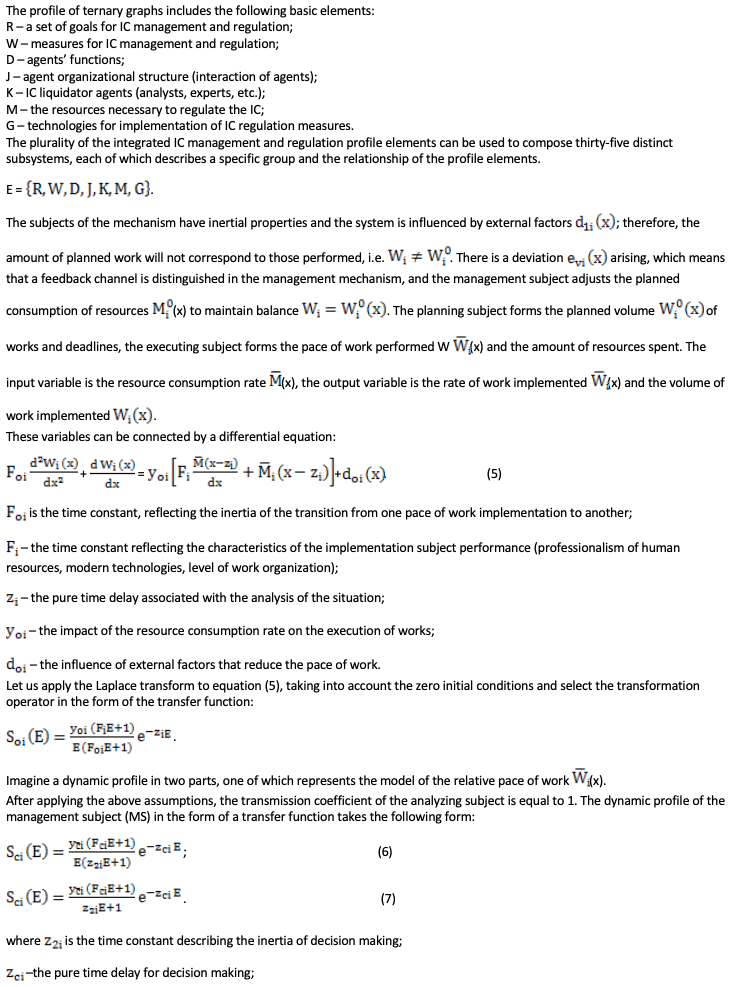
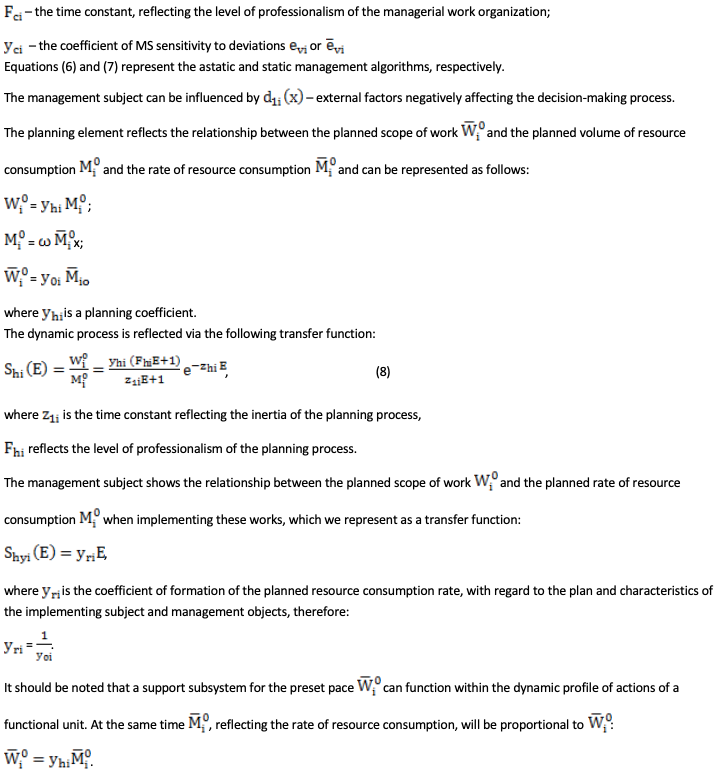
All operational management systems have a combined control principle, which means that feedback control is combined with open-loop control.
The interrelation of the head management element (hereinafter referred to as the IC HME) with the functional units contains the following main provisions. Firstly, the IC HME manages the functional component (FC) through planning and allocating funds upon FC requests. Also, the IC HME is the center for the supply of resource sources to provide the FC operation. FC, in turn, carrying out the planned scope of work using the resources provided, submit the data on the funds used and form the subsequent requirements.
At their discretion FCs allocate the HME requirements for the planned rate of resource expenditure, taking into account the conflict potential, the available funds, and the required rate of the IC regulation.
It follows from the above that it is possible to model the probable directions of IC and to construct the IC OM mechanism, which reveals the value of each agent in the management algorithm, as well as the effect of management deficiencies on the final result.
The following basic results were obtained in the study:
1. The principles, requirements and stages of IC modeling have been formulated that are necessary for the qualitative and timely management of the conflict process and decision-making on its regulation, enabling to investigate the conflict as a dynamic, multilateral and complex process, taking into account the risk of IC occurrence.
2. An agent-based IC management and resolution system has been developed based on a multi-agent approach.
3. Formulas (5-8) were used to obtain transient curves for the resolution of a bilateral IC on the basis of computational simulation in the MATLAB 9.3 environment.
4. A software complex “IC plus” has been developed.
Figure 3
Transition processes to resolve a bilateral international
conflict during the autonomous operation of two FCs:
a) Changes in the indicators IC/1 and IC/2 during
liquidation and change in the damage O1 and O2;
b) Total damage from the international conflict
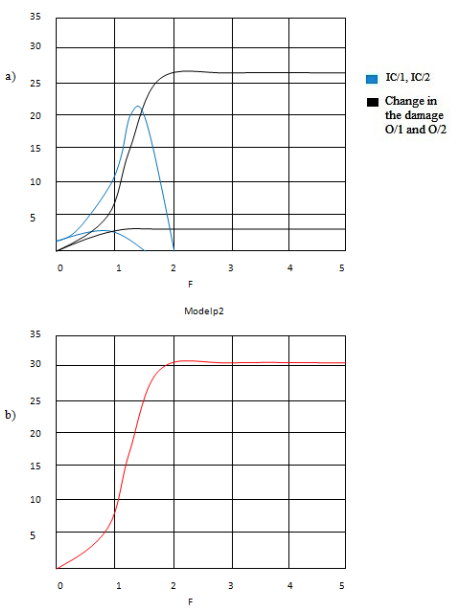
-----
Figure 4
Transition processes to resolve a bilateral
international conflict by three FCs:
а) Changes in the indicators IC/1 and IC/2 during liquidation
and total damage from the international conflict;
b) Change in the damage O1 and O2;
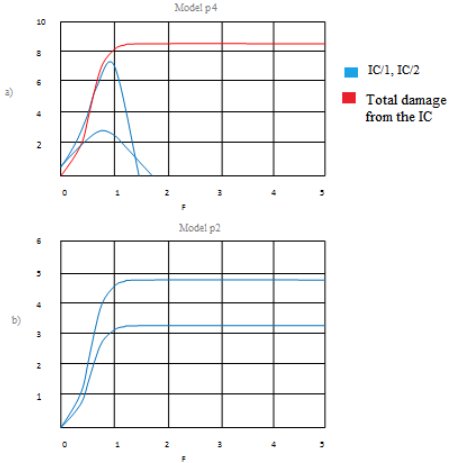
Based on computational simulation in the MATLAB 9.3 environment, transient curves for the IC resolution were obtained according to the resolution of the MC. The obtained simulation results were analyzed for each curve.
Figure 3 shows the transient processes when resolving a bilateral IC, taking into account the autonomous operation of several functional components. The curves reflect the effectiveness of the activities of the functional components at certain points in time (F). At F = 2, the rate of rise in IC/2 is equal to zero, and at F = 1.5, IC/1 is equal to zero, which means that the IC is effectively resolved with the autonomous functioning of both FCs. And here the damage from IC/1 makes 4 units, the damage from IC/2 amounts to 26 units, with the total damage being 30 units.
Figure 4 shows the transition processes when resolving a bilateral IC, in which the first FC and the second FC act independently of each other, and the third FC regulates the part of the international conflict that is rapidly developing or carries a greater degree of threat.
It is clear from the presented figures that in case of the autonomous functioning of two FCs and the participation of the third FC the damage from the first IC amounts to 3.3 units, the damage from the second IC makes 4.8 units, with the total damage from the conflict being 8.1 units, i.e., it is reduced by more than half.
This means that the use of three FCs causes the greatest efficiency in resolving a bilateral IC. With the use of three FCs for IC resolution, the maximum positive effect is observed.
Therefore, it can be concluded that the models presented describe the dynamics of development and resolution of a bilateral conflict by several FCs, enable to assess damages inflicted and make the right managerial decision on the conflict situation.
The practical significance of the study lies in the new scientific results in the field of studying complex dynamic systems, which are international conflicts operating under uncertainty, identifying links and regularities that enable to formalize and organize decision support by government bodies on international conflicts. And also its significance is determined by the solution of the important problem of improving information support of the decision-making process in the field of forecasting international conflicts.
The presented computational simulation of the process of managing international conflicts is based on the implementation of a new approach consisting in the purposeful selection of the parameter values of the state of the resource support system used in the regulation of IC with a comprehensive account of factors determining the magnitude of possible damage from the IC.
Aksenov, K. A., Antonova, A. S., and Spitsina, I. A. (2011). Analysis and synthesis of resource transformation processes based on simulation and intelligent agents. Scientific and Technical Reports of SSPU, 1, 13-20.
Alibekov, B. I., and Mamaev, E. A. (2017). Multi-agent systems in logistics: information and analytical aspects. Bulletin of the DSU, 4, 56-62.
Antonova, A. S., and Aksenov, K. A. (2012). Multi-criteria decision making under risk based on the integration of multi-agent, simulation, evolutionary modeling and numerical methods. Don Engineering Bulletin, 4-2, 99-106.
Avdeenko, T. V., and Vasilyev, M. A. (2010). Multi-agent approach using fuzzy modeling in the problem of multi-criteria decision making. Scientific Bulletin of NSTU, 1, 63-74.
Bogdanova, V. G., Bychkov, I. V., Korsukov, A. S., Oparin, G. A., and Feoktistov, A. G. (2014). Multi-agent approach to the management of distribution computing in a cluster GRID-system. Proceedings of the Russian Academy of Sciences, 5, 95.
Bova, V. V., and Dukkardt, A. N. (2012). The use of artificial neural networks for the collective solution of intelligent problems. SFU News, 7, 131-138.
Bychkov, I., Oparin, G., Feoktistov, A., Bogdanova, V., and Pashinin, A. (2014). Multiagent methods and tools of management in a service-oriented distributed computing environment. Proceedings of the Institute for System Programming, 26(5), 65-82.
Feng, Z., Liu, J., Peng, L., Zhou, Y., Ning, P., and Wang, B. (2016). New development of CAE platform and computational mechanics software. Journal of Southwest Jiaotong University, 51(3), 519-524.
Garbuk, S. V. (2016). Prospects for the application of intelligent technologies to solve security problems. National Security, 4, 451-457.
Gelaim, T. Â., Hofer, V. L., Marchi, J., and Silveira, R. A. (2019). Sigon: A multi-context system framework for intelligent agents. Expert Systems with Applications, 119, 51–60.
Inozemtsev, S. V., and Dmitriev, A. Yu. (2012). Current problems of practical use of multi-agent systems. Software Products and Systems, 3, 12.
Kovalenko, I., Tilbury, D., and Barton, K. (2019). The model-based product agent: A control oriented architecture for intelligent products in multi-agent manufacturing systems. Control Engineering Practice, 86, 105-117.
Kulba, V. V., Schulz, V. L., Shelkov, A. B., and Chernov, I. V. (2013). Methods and mechanisms of planning and management in emergency situations. Trends and Management, 2, 134-155.
Menga, X., Xie, L., and Soh, Y. C. (2019). Reset control for synchronization of multi-agent systems. Automatica, 104, 189-195.
Muda, I., Landau, S. N., and Erlina. (2019). The implementation theory of conservative accrual accounting to the quality of accounting information systems. Journal of Southwest Jiaotong University, 54(1), http://jsju.org/index.php/journal/article/view/266.
Nagoev, Z. V. (2012). Multiagent recursive cognitive architecture. Biologically Inspired Cognitive Architectures 2012, Proceedings of the third annual meeting of the BICA Society, in Advances in Intelligent Systems and Computing series, Springer, pp. 247-248.
Nagoev, Z. V., Nagoeva, O. V., and Pshenokova, I. A. (2017). Formal model of semantics of natural language statements based on multi-agent recursive cognitive architectures. Proceedings of the RAS Kabardino-Balkar Scientific Center, 4(78): 19-31.
Rizvanov, D.A. (2016). Methodological bases of decision support in managing resources in complex systems in a dynamically changing external environment. Information and Mathematical Technologies in Science and Management, 3, 92-101.
Rizvanov, D. A., and Yusupova, N. I. (2015). Intelligent decision support in resource management of complex systems based on a multi-agent approach. Ontology of Design, 3, 297-312.
Samorodov, A. V. (2012). Features of multiclassifier construction based on the methods of solution integration. Engineering Journal: Science and Innovation, 3, 1-11.
Shunkevich D. V. (2013). Multi-agent approach to building knowledge processing machines based on semantic networks. Cybernetics and Programming, 1, 37-45.
Shvetsov, A. N., and Dianov, S. V. (2015). Multi-agent information technology of solving managerial and decision-making problems in an organizational system. Bulletin of ChSU, 2, 49-54.
Skobelev, P. O. (2013). Situational management and multi-agent technologies: a collective search for consistent solutions in the dialogue. Ontology of Design, 2, 26–48.
Vittikh, V. A., Rzhevsky, G. A., and Skobelev, P. O. (2002) Multi-agent interaction models in decision-making processes. Proceedings of the 4th International Conference on the Complex System Management and Modelling. Samara. June 17-24, 2002. Samara: RAS SSC, pp. 116-126.
Yatsenko, I. A. (2014). Problems of scientific provision of public administration and managerial decision support process. Law and Politics, 8, 1133-1138.
Zheng, Y., Zhao, Q., Ma, J., and Wang, L. (2019). Second-order consensus of hybrid multi-agent systems. Systems and Control Letters, 125, 51-58
Zraenko, A. S., Aksenov, K. A., and Wai, K. (2009). The Coalition Model of the Multi-agent Resource Transformation Process. Scientific and Technical Reports of the SSPU, 5, 156-161.
1. Ph.D. Student. Department of Economics, Management and Production Organization. Stary Oskol Technological Institute, National University of Science and Technology "MISIS", Stary Oskol, Russia
2. Candidate of Engineering Sciences, Associate Professor. Head of the Department of Higher Mathematics and Informatics, Stary Oskol Technological Institute, National University of Science and Technology "MISIS", Stary Oskol, Russia. kabulova.evgenia@mail.ru
3. Engineer, Stary Oskol Technological Institute, National University of Science and Technology "MISIS", Stary Oskol, Russia